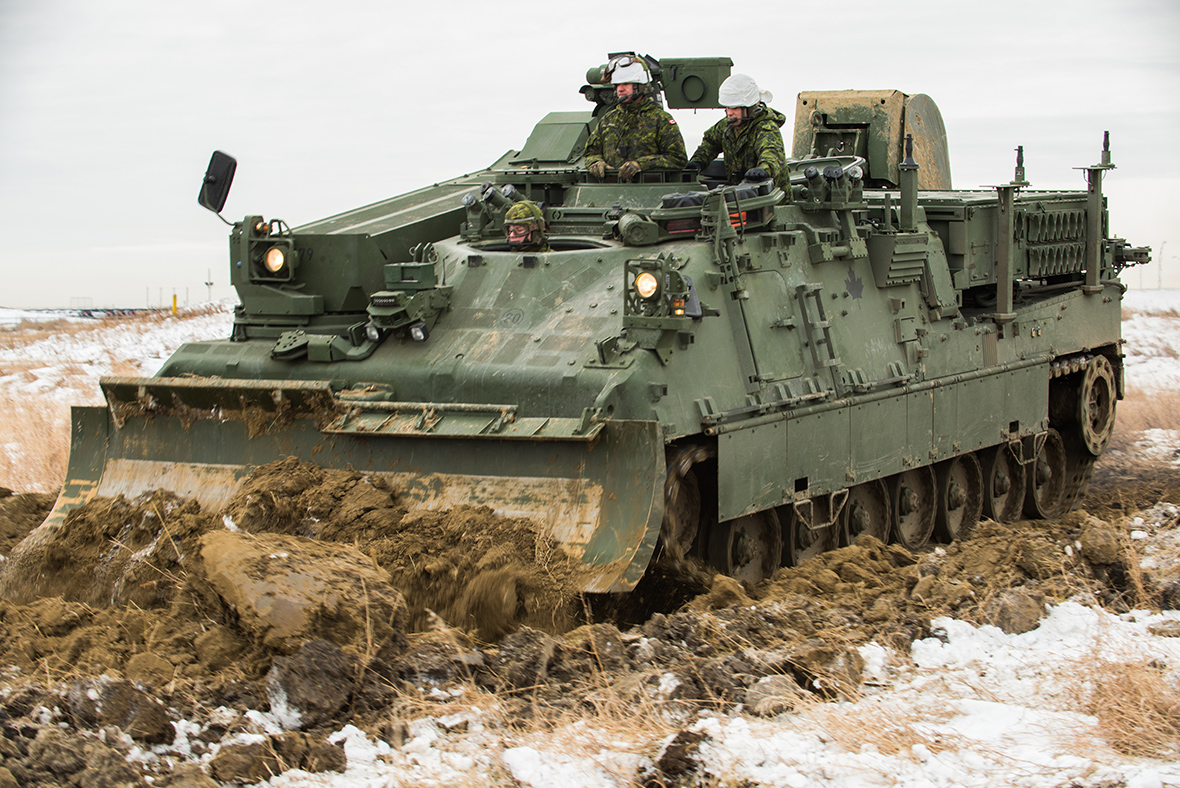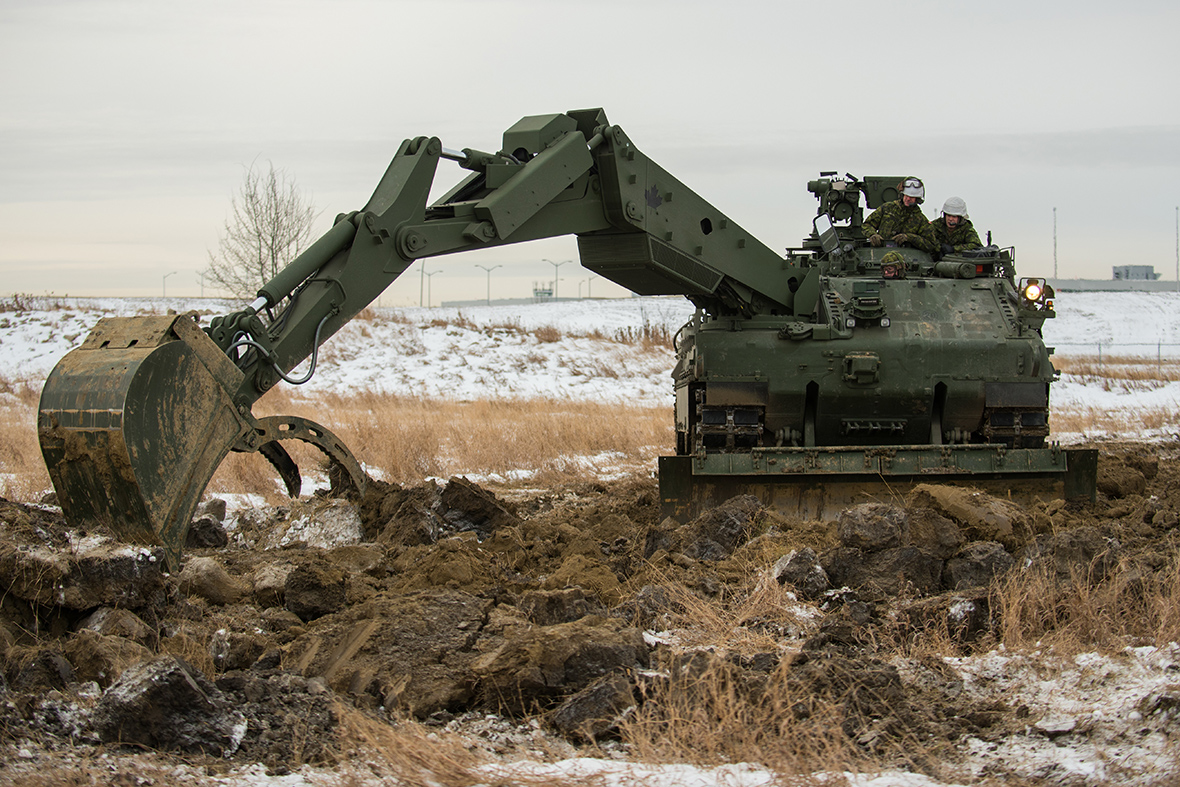Force mobility enhancement
Project summary
The Government of Canada has acquired a fleet of 18 Armoured Engineer Vehicles, and four Armoured Recovery Vehicles that will provide crucial support to the Leopard 2 tanks, the Light Armoured Vehicles, and the Tactical Armoured Patrol Vehicle. The project has also delivered tactical mobility implements to be used on the fleet of Leopard 2 main battle tanks.
The Force Mobility Enhancement (FME) project provides the Canadian Army with a flexible, multi-purpose capability that will enable the Canadian Armed Forces (CAF) to respond effectively and successfully to the full spectrum of military operations. This project is part of the family of land combat vehicles, announced in July 2009.
The FME occurred in two phases:
Phase 1: Acquisition of the main battle tank chassis (complete)
- acquisition of the Leopard 2 main battle tank chassis from the Swiss government
- conversion of the main battle tanks into Armoured Engineer Vehicles
- acquisition of Armoured Recovery Vehicles through a competitive process
Phase 2: Tactical Mobility Implements (complete)
- bulldozer blades and Leopard 2 modifications by Krauss‐Maffei Wegmann
- mine-clearing rollers systems by Urdan, production of track-width mine ploughs, work that the Department of National Defence will do internally
Project phases
Currently in Phase 4: Implementation
1. Identification
1. Identification
- September 1, 2008
2. Options analysis
2. Options analysis
- September 1, 2008-June 18, 2009
3. Definition
3. Definition
- Preliminary Project Approval: 18, June 2009
4. Implementation
4. Implementation
- Project Approval (Implementation) Phase 1: March 2012
- Contract award For Armoured Recovery Vehicle: March 2012
- Contract award for Armoured Engineering Vehicle: April 2012
- Initial operational capability Phase 1: December 2017
- Project Approval Phase 2: November 2013
- Contract award for Mine Clearing Roller System: December 2013
- Contract award for Dozer Blades, Track Width Mine Ploughs: December 2013
- First delivery of armoured engineer vehicles: October 15, 2015
- Last deliver: February 22, 2016
- Initial operational capability: December 2017
- Full operational capability: December 2018
5. Close-out
5. Close-out
- Effective: March 2019
- Project closeout: March 2020
Additional information
- Learn more about the Defence procurement process
Project updates
Project updates
Phase 1:
December 2018:
Deliveries of equipment from both phases was completed.
April 2018
Eleven of 18 Optimized Front Protection (OFP) modifications were completed and accepted. Sixteen of 18 Armoured Engineer Vehicles were accepted; production and acceptance continue on the remaining vehicles.
November 2016
All Armoured Engineer Vehicle Add-On Armour kits were accepted.
April 2016
Five of 18 Armoured Engineer Vehicles are accepted. Production and acceptance are continuing for the remaining vehicles.
March 2016
Six of 14 Armoured Engineer Vehicle Add‐On Armour kits are accepted.
January 2016
Four of Four Armoured Recovery Vehicles are delivered.
February 2014
14 of 14 Armoured Engineer Vehicle Mine Breaching Systems are accepted by the Canadian Army.
Phase 2:
November 2018
Deliveries are complete.
May 2018
Seventy of 82 Leopard 2 Main Battle Tanks have been modified for Tactical Mobility Implements (TMI); modifications are continuing for the remaining vehicles.
October 2017
Sixteen of 16 track width mine plows were produced.
April 2017
Eighteen of 18 dozer blades were produced.
November 2016
Sixteen of 16 mine clearing roller systems were delivered.
April 2016
20 of 82 Leopard 2 Main Battle Tanks modified for Tactical Mobility Implements. Modifications are continuing for remaining vehicles.
March 2016
10 of 16 Mine Clearing Roller Systems delivered.
October 2015
One of 18 Dozer Blades produced.
March 2015
One of 16 Track Width Mine Plows prod.
Benefiting Canadian industry
Benefiting Canadian industry
Phase 1
A Letter of Interest to industry was published in fall 2009 for Armoured Engineer Vehicle, including the mine breaching system.
Phase 2
Draft competitive Statement of Work was released for industry review for Dozer Blades and Main Battle Tank modifications. Krauss-Maffei Wegmann advised only they could perform the work due to Intellectual Property ownership.
Advance Contract Award Notification was posted in July 2011 and unchallenged.
Urdan self-identified as owning Intellectual Property necessary to conduct the work for the mine clearing roller system. Advance Contract Award Notification was published in fall 2012.
The Industrial and Regional Benefits Policy was applied to the Armoured Engineer Vehicle (AEV) contract. Total IRB Obligations total $160 million. As of May 2018, $88 million were completed and $40 million were in progress.
For more information, visit Innovation, Science and Economic Development Canada’s website:
Contractors
Some of the links below lead to websites that are not part of the Government of Canada and may be available in English only.
- FFG
- Armoured Engineer Vehicles
- Rheinmetall Landsysteme GmbH (RLS)
- Armoured Recovery Vehicles
- Krauss-Maffei Wegmann (KMW):
- Dozer blades and Leopard 2 modifications
- Urdan Metal & Casting Industries Ltd.
- Mine Clearing Rollers Systems
Technical information
Technical information
FME technical specifications
Leopard 2 Armoured Engineer Vehicle
Weight
- Basic weight: 61 350 kilograms
- Combat load: 69 500 kilograms
Dimensions
- Length: 10.6 metres
- Width: 4.2 metres
- Height: 3.2 metres
Crew
- Personnel: 3
- Passengers: 0
Leopard 2 Armoured Recovery Vehicle
Weight
- Basic weight: 55 tonnes
- Combat load: 63.8 tonnes
Dimensions
- Length: 9.50 metres
- Width: 3.70 metres
- Height: 2.86 metres
Crew
- Personnel: 3
Project costs
Project costs
The FME contract is worth $356 million, which includes the procurement of the Armoured Engineer Vehicle, the acquisition of the Armoured Recovery Vehicle, the modifications to the Leopard main battle tank, and the procurement of the bulldozer blades.
Issues/Risks
Schedule
There is a potential risk with the Recovery Vehicles that has been identified. Rheinmetall Landsysteme GmbH, has been tasked to investigate the issue and is scheduled to provide its findings in fall 2018. Project impact and mitigations are being assessed.
Budget
Fifty-six percent of Phase 1 contingency funding has been released to address cost increases predominantly associated with ancillaries and infrastructure. All of Phase 2 contingency funds remain unallocated. Overall, the project is expected to remain within the approved expenditure authority.


